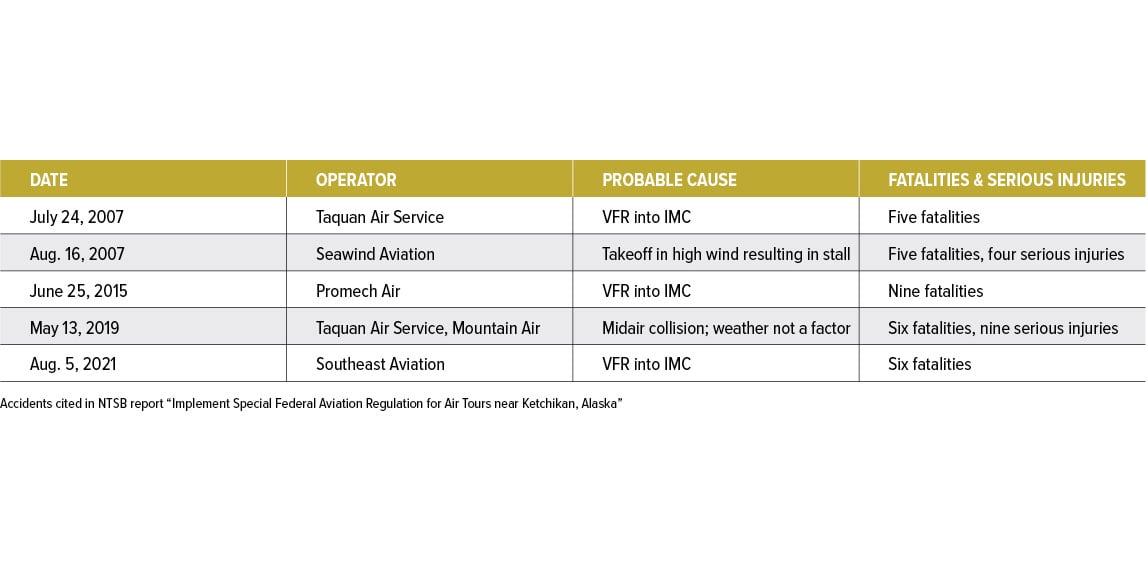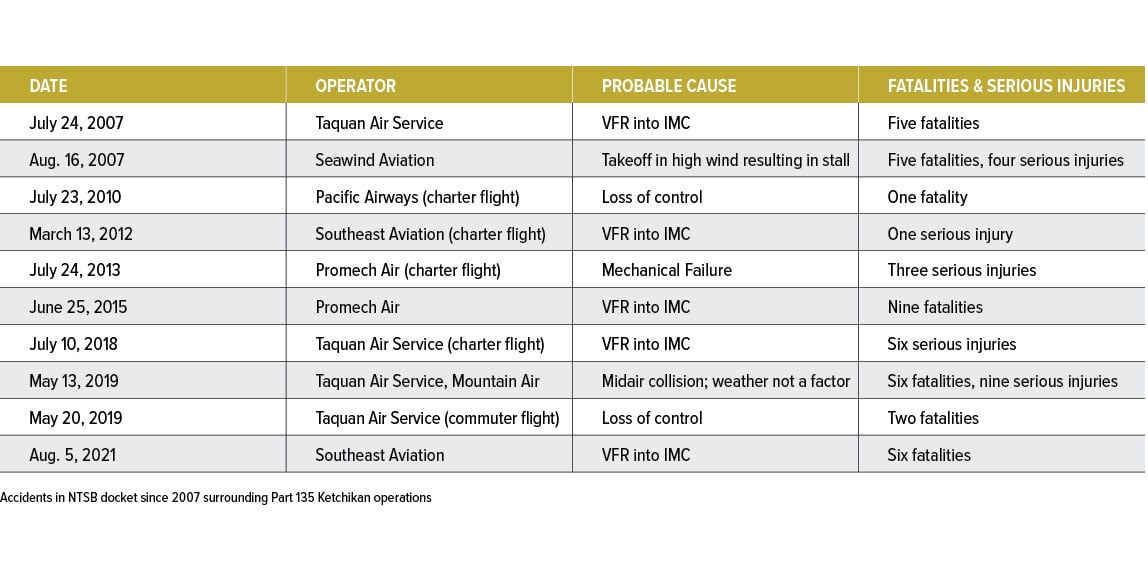Click Here to View This Page on Production Frontend
Click Here to Export Node Content
Click Here to View Printer-Friendly Version (Raw Backend)
Note: front-end display has links to styled print versions.
Content Node ID: 414094
The National Transportation Safety Board (NTSB) recently added three more recommendations to those already issued surrounding air tour safety in Ketchikan, Alaska.
The latest recommendations, included in a short report, call for a special federal aviation regulation (SFAR) to be developed for Ketchikan air tour flights, the imposition of weather minimums more conservative than Part 135, and a pilot training requirement focused on reducing continued VFR into IMC.
In that report, the Safety Board highlighted five fatal accidents in the region between 2007 and 2021 and found that despite FAA efforts over the past 15 years to motivate voluntary adoption of safety procedures, tour flights were still “vulnerable to the hazards unique to the area’s terrain and weather conditions.”
Unfortunately, the report ignores information from comparable accidents involving non-air tour operations and fails to consider the impact of funding limitations on FAA oversight and critical weather--reporting infrastructure.
Ketchikan is a Southeast Alaska community with about 14,000 year-round residents. As a primary destination on the cruise ship circuit, and gateway to Misty Fjords National Monument, the town welcomes an estimated 1.1 million annual visitors. From May through September, scenic air tours are a significant part of the local aviation industry.
While these flights are operated by both helicopters and airplanes, the NTSB focused on fixed-wing operations in its recent report. The report also did not address the area’s commuter and charter activities, which are generally flown by the same companies at the same time.
The NTSB previously issued 13 safety recommendations to the FAA directed toward Ketchikan air tour operations. The first four, in 2008, were directed broadly to all of Southeast Alaska and in response to five specific regional accidents that occurred between 1999 and 2007. They called for the installation of weather cameras in the Southeast, formalization of FAA tour flight surveillance, and mandated specialized training requirements concerning flight operations and weather-related decision-making.
In the latest report, three of those accidents, which involved helicopter companies, are included only as a footnote. (A fourth, involving L.A.B. Flying Service in the town of Haines, is largely ignored. That company was shut down by the FAA via an emergency revocation of its operating certificate in 2008.)
From the original list, the NTSB references a 2007 Taquan Air Service crash and then adds four subsequent Ketchikan air tour accidents (see chart below). 
Two years after the 2015 Promech Air crash, the NTSB issued nine more recommendations to the FAA, four of which specifically addressed Ketchikan operators. One encouraged use by all companies of more modern terrain databases and instrument system software.
Three others focused on air tour operators and called for improved training programs to reduce the risk of weather--related accidents, ongoing analysis of ADS-B route data (and meeting with companies to discuss hazards in a nonpunitive manner), and the development and implementation of special operating rules to establish VFR minimums more conservative than Part 135.
As noted in the current report, some of those recommendations languished, particularly the development and implementation of more conservative VFR minimums. Initially, the FAA responded that it was “evaluating policy and rulemaking options,” which was deemed an acceptable response.
But after three years without specifics, the Safety Board reopened the recommendation in 2020. By then, the FAA was building a working group to investigate overall Part 135 air safety in Alaska, an initiative that was formed in response to yet another NTSB safety recommendation, which was issued after the board’s 2019 Anchorage roundtable on the subject.
The FAA informed the NTSB in 2022 that the group’s report, the FAA Alaskan Aviation Safety Initiative (FAASI), discussed a need statewide for “improved weather reporting facilities.” As it did not mention Ketchikan nor the recommendation’s requirement for more conservative weather minimums, the NTSB was unimpressed. And so, returning to the issue again, the most recent NTSB report declared that as air tour accidents continue to occur, recommendations for the FAA to develop an SFAR, increase training, and establish more conservative VFR minimums are necessary.
Essentially, the NTSB wants the FAA to finally fix whatever is wrong with Ketchikan. The problem is that the NTSB has not addressed the fact that the FAA cannot satisfy this demand with its typical Juneau FSDO staffing levels. The evidence of this longstanding problem can be found in the NTSB’s Ketchikan-area Part 135 accident dockets, starting with the investigation into the 2007 crash involving Seawind Aviation. (The 2007 Taquan Air accident docket includes no interviews with FAA personnel.)
The principal operations inspector (POI) for Seawind told investigators that he had responsibility for about 33 Part 135 operators at the time of the crash. One of only two POIs at the FSDO, he was based in Juneau and traveled to Ketchikan once a month. At this time, the Juneau FSDO was responsible for oversight of 51 operations. According to the manager, it had curtailed services due to decreased staffing.
There are no interviews of FAA personnel in the docket for the 2010, 2012, and 2013 Pacific Airways, Southeast Aviation, and Promech Air accidents. Following the 2015 Promech crash that killed nine, the POI told investigators he was responsible for 21 certificates and also one of only two inspectors at the FSDO able to conduct checkrides, which took up a lot of his time.
In commenting on the events over the year, he admitted, “2015 had been a challenge.” He tried to visit Ketchikan twice a month during the summer season but prior to the accident had been there only once. At this time, the Juneau FSDO was responsible for oversight of 71 operators.
In 2018 and 2019, Taquan Air Service was involved in three serious accidents that brought the company national attention. 
In the investigations that followed, it was discovered that Taquan had five different POIs between January 2018 and March 2019. These included three from the Juneau FSDO, one of whom told investigators he was responsible for 20-30 certificates then later said: “over 25, less than 50.” He described the number as difficult to pin down because it was “changing weekly.”
Another said he was responsible for about 40 separate operators and the third, who served as POI from March 2019 to September 2020, said his workload varied widely from 30 certificates as a low and 67 as a high.
The other two POIs for Taquan were assigned from Columbia, South Carolina. According to one of them, South Carolina inspectors were assigned about a dozen Part 135 operators from Ketchikan for a period of several months beginning in August 2018 as “Juneau had only one ops inspector for the district.”
He made one trip to Ketchikan, and the POI who took Taquan after him did not go to Alaska at all. According to the FSDO manager, during this period, the Juneau FSDO was responsible for oversight of about 160 operators. According to the front-line manager, the inspectors were responsible for oversight of about 80 certificates. Neither man was certain of the actual number or type of operations.
After the 2021 Southeast Aviation accident, its POI described his workload as heavy, telling investigators, “a lot.” He managed 21 Part 135s including all of the Part 135 operators in Ketchikan but lived in Juneau. There were four POIs assigned out of the FSDO at that point but since then the number has reduced; there are now three listed on the employee directory (and an aviation safety inspector). Also, one of the current POIs is remotely based in Ketchikan.
It is unclear how many certificates the FSDO was responsible for in 2021 as management was not interviewed.
Overall, the NTSB’s “Implement Special Federal Aviation Regulation for Air Tours near Ketchikan, Alaska” report joins a litany of previous studies, initiatives, reports, and analyses on Alaska that have each concluded a lack of weather information is a crucial factor in the state’s flight safety concerns.
The FAASI report, cited by the board, includes 85 mentions of the word “weather,” and increased weather reporting, both via cameras and certified weather sources, is a dominant theme in its appendix of stakeholder comments.
By demanding the establishment of more conservative VFR minimums for Ketchikan scenic air tour flights without addressing the dearth of weather resources and continued FAA staffing issues, the NTSB may be asking for solutions that are impossible to provide. In the process, it contributes to the seemingly endless discussions of the problems in Alaska, while the FAA lacks the funding to fix them.
In December the FAA held a webinar providing an overview of its weather camera program and plans for expansion; participants were directed to a form where prospective sites could be submitted. In Alaska, the last FAA weather camera was installed in 2016.
When asked by AIN about expansion in the state, the agency responded that it “is evaluating whether it can install additional weather cameras in Alaska and the Continental United States. Approvals for installation will be decided later this year. No immediate plans for new sites exist.” z